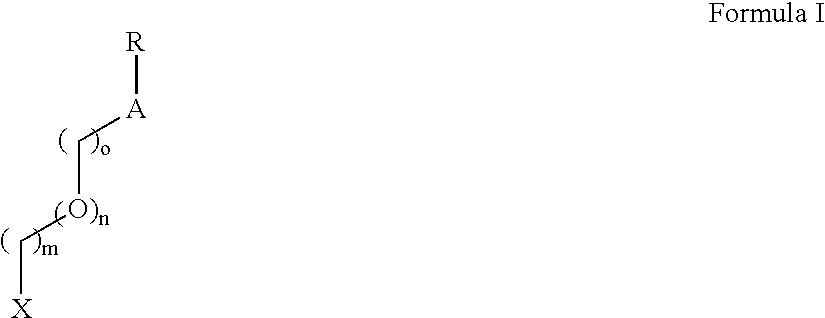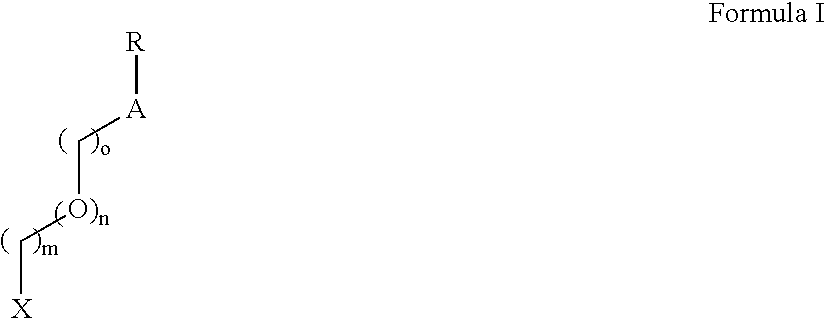Durable finishes for textiles
a technology of textiles and finishes, applied in the field of textile treatment compositions, can solve the problems of inability to apply existing textile production processes, high cost of synthesis of films, and significant higher cost of garments with this modification, so as to improve the water solubility or stability of the suspension of polymers, flame retardancy, and the softness of textiles.
- Summary
- Abstract
- Description
- Claims
- Application Information
AI Technical Summary
Benefits of technology
Problems solved by technology
Method used
Image
Examples
example 1
Application of Fluoropolymer Solution to Cotton
Polymer solution preparation: 9.06 g 95% water / 5% isobutanol, 1.04 g 1 M NaOH, and 1.0 g of fluoropolymer were mixed together in THF. The polymer was about 40 wt. % of the solution. The polymer composition was: 3:1 acrylic acid:FX-13 polymer, 1% mercaptosuccinic acid (“100-mer”). The polymer completely dissolved. 1450 μL of dilute acid (4.15 g 50% H3PO2 in water in 40.02 g water) was added slowly while the polymer solution was stirred, reducing the pH to 3.42. This solution was padded onto 2 cotton samples, which were dried in an oven at 90° C. and then cured for 5 and 15 minutes at 160° C. The samples were placed in a rotowash for 45 minutes (equivalent of 5 home launderings). They were then rinsed for 1 minute in flowing tap water and finally dried at 90° C.
Both samples had the same results in tests for repellency: Water beaded up on them. 81 % Methanol in water (27.1 dynes / cm) beaded up. Decane wet the samples. Dodecane beaded up.
example 2
Since softness is very subjective and not easy to measure, the durability of the finish was determined by observing the hydrophobicity of the cotton. By placing a drop of water on the treated surface, it is possible to measure the time it takes for the drop to completely soak into the material. This is referred to as the time to wet (TTW). Untreated cotton fabric wets instantly (TTW<1 second), while polybutadiene-treated fabric generally exhibits hydrophobicity (TTW>10 seconds). It has been noticed that when there is evidence of hydrophobicity on the cotton surface, the cotton is softer and more supple than the untreated fabric.
An aqueous dispersion of Ricon 130MA8 maleinized polybutadiene (Ricon Resins, Inc., Grand Junction, Colo.) was prepared at a concentration of 2% polymer (by weight) with 1 % catalyst (sodium hypophosphite) at a pH of 4.5. A 7.5-oz bleached white twill-weave cotton fabric was dipped into the solution and padded to approximately 70% wet pick-up. The fabric...
example 3
Fabric treated similarly to Example 1 was tested for abrasion resistance using the ASTM D3885-92 “Standard Test Method for Abrasion Resistance of Textile Fabrics (Flexing and Abrasion Method)” with 1 pound load, 4 pound tension. The results are included in the table below:
TABLE 2Flex Abrasion CyclesSample(warp × fill)Treated>1000 ×>1000Untreated240 × 220
PUM
| Property | Measurement | Unit |
|---|---|---|
| Electrical resistance | aaaaa | aaaaa |
| Surface | aaaaa | aaaaa |
| Abrasion resistance | aaaaa | aaaaa |
Abstract
Description
Claims
Application Information
 Login to View More
Login to View More - R&D
- Intellectual Property
- Life Sciences
- Materials
- Tech Scout
- Unparalleled Data Quality
- Higher Quality Content
- 60% Fewer Hallucinations
Browse by: Latest US Patents, China's latest patents, Technical Efficacy Thesaurus, Application Domain, Technology Topic, Popular Technical Reports.
© 2025 PatSnap. All rights reserved.Legal|Privacy policy|Modern Slavery Act Transparency Statement|Sitemap|About US| Contact US: help@patsnap.com



